| |
 |
Subscribe to the
Research Digest, or Read Online |
|
| |
|
|
Connecting Social Norms to Environmental Policy
Politicians face unique challenges in planning for the future. It is often the short-term acceptability of potential policies, rather than their longer-term efficacy, that determines their scope and deployment. A paper co-authored by Stanford Woods Institute Senior Fellows Paul Ehrlich (Biology) and Gretchen Daily (Biology) and Woods-affiliated Professor of
Economics (Emeritus) Kenneth Arrow provides a possible solution. Arrow, Daily and Ehrlich call on academic
researchers to provide decision-makers with insight on how social norms and policy instruments evolve together. This way, leaders would better understand how society might adapt to a land
conservation initiative, for example. Scientists could make fundamental contributions to this agenda through targeted research on the emergence of social norms.
"Social Norms and Global Environmental Challenges: The Complex Interaction of Behaviors, Values and Policy," BioScience, March 2013
Read on for more summaries of the most recent research on environmental challenges and solutions published by Stanford Woods Institute fellows, affiliated faculty and fellows with our Leopold Leadership Program. We invite you to subscribe to our quarterly Research Digest.
|
|
|
| |
| |
 |
 |
Changing Climate Could Bring Bad Air
Stagnant atmospheric conditions can lead to hazardous air quality by allowing ozone and particulate matter to accumulate and persist in the near-surface environment. By changing atmospheric
circulation and precipitation patterns, global warming could alter the meteorological factors that regulate air stagnation frequency, according to a study co-authored by Center Fellow Noah Diffenbaugh (Earth Sciences). The study finds that
atmospheric conditions over the highly populated, industrialized regions of the eastern United States, Mediterranean Europe and eastern China are particularly sensitive to global warming, with the
occurrence of stagnant conditions projected to increase by 12 to 25 percent relative to late-20th century stagnation frequencies.
Read more ...
"Response of Air Stagnation Frequency to Anthropogenically Enhanced Radiative Forcing," Environmental Research Letters, Nov. 27, 2012 |
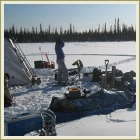 |
Stanford-Led Team Pioneers New Way to Survey Thawing Arctic
In the snows of Alaska, a Stanford-led team of researchers, including Senior Fellow Rosemary Knight (Earth Sciences), discovered a new way to determine if the soil beneath lakes, normally frozen, is thawing as a result of
climate change. If so, the lakes could become a new source of methane, a global warming gas. The team's measurements help explain how thawing permafrost could affect the climate.
Read more ...
"Detecting Unfrozen Sediments Below Thermokarst Lakes With Surface Nuclear Magnetic Resonance," Geophysical Research Letters, Feb. 11, 2013 |
 |
Global Warming Agent Found to be Much Stronger Than Thought
Scientists have long known that black carbon - particles emitted into the atmosphere by burning diesel fuel, biomass and other solid fuels - contributes to global warming. Most previous
estimates of the soot component’s heat-trapping power, however, have been off by a factor of almost three, according to a study co-authored by Senior Fellow Mark Jacobson (Civil and Environmental
Engineering). The study calls black soot the "second most important human emission in terms of its climate-forcing in the present-day atmosphere," behind only carbon dioxide.
Read more ...
"Bounding the Role of Black Carbon in the Climate System: A Scientific Assessment," Journal of Geophysical Research: Atmospheres, Jan. 15, 2013 |
| |
Other Climate Change Research
"Assessment Report From the GCEP
Workshop on Energy Supply With Negative Carbon Emissions," February 2013, co-authored by Senior Fellow Chris Field (Biology). Read more ...
|
| |
More information about Stanford Woods Institute climate research |
| |
 |
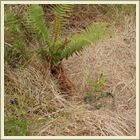 |
More Efficient Ecological Restoration
Ecological restoration is an increasingly important component of sustainable land management, and billions of dollars are invested in it worldwide each year. A study led by Stanford graduate student Rachelle Gould and co-authored by Senior Fellows Hal Mooney (Biology)
and Gretchen Daily (Biology) looks at ways to restore native forest
understory with an eye toward cost-effectiveness. Among its findings: Seedlings planted near native ferns - virtually the only native plants that can compete with Hawaii’s invasive pasture
grasses - have a significantly higher rate of survival than those planted in open grassland. Moreover, germinating seeds in a nursery, then planting them in the field, costs about 20 percent less
than direct seeding in the field. The study reveals practical, cost-effective ways of increasing the extent and effectiveness of restoration efforts.
Read more...
"Restoring Native Forest Understory: The Influence of Ferns and Light in a Hawaiian Experiment," Sustainability, March 20, 2013 |
 |
Finding Pathways to Conservation
A study co-authored by Center Fellow Nicole Ardoin (Education) collected data through surveys, interviews and discussion groups to explore the use of social strategies such as education and outreach by nongovernmental organizations and
government agencies to reach outcomes related to biodiversity conservation and resource management. Ardoin and fellow researchers examined how conservation practitioners and educators perceive
education’s ability to help achieve conservation and resource management goals. The researchers also explored how to better integrate education efforts with science and policy. The study
suggests ways for conservation organizations to more effectively use education and social strategies, along with other conservation activities.
Read more...
"Views From the Field: Conservation Educators' and Practitioners' Perceptions of Education as a Strategy for Achieving Conservation Outcomes," Journal of Environmental Education, Jan. 11, 2013 |
 |
Putting Food Chains in Context
What affects the length of a food chain? A study co-authored by Senior Fellows Rodolfo Dirzo (Biology) and Rob Dunbar (Earth Sciences) found that an
insular ecosystem's size has no effect on terrestrial food chain length, but its productivity has a strong effect, likely through a combination of changes in predator size, predator behavior and
consumer diversity. These results lend new insight into the mechanisms by which productivity can drive changes in food chain length, point to potential for systematic differences in the drivers of
food web structure between terrestrial and aquatic systems, and challenge us to consider how ecological context may control the drivers that shape food chain length.
Read more...
"The Roles of Productivity and Ecosystem Size in Determining Food Chain Length in Tropical Terrestrial Ecosystems," Ecology, March 2013 |
| |
Other Ecosystem Services Research
"Achieving the Triple Bottom Line in the Face of Inherent Trade-Offs Among Social Equity, Economic
Return and Conservation," Proceedings of the National Academy of Sciences, March 28, 2013, co-authored by Consulting Professor Mary Ruckelshaus, managing director of the Natural Capital Project
"A Meta-Analysis Suggesting That the Relationship Between Biodiversity and Risk of Zoonotic Pathogen
Transmission Is Idiosyncratic," Ecology Letters, March 11, 2013, co-authored by Senior Fellow James Holland Jones (Anthropology) and former Woods-affiliated ecologist Dan Salkeld. Read more...
"Effects of Climate Change on Range Forage Production in the San Francisco Bay Area," PLoS ONE, March 5,
2013, co-authored by Woods-affiliated research associate Becky Chaplin-Kramer (Natural Capital Project)
"Modeling Marine Ecosystem Services" chapter in Encyclopedia of Biodiversity (Second Edition, Volume 1), Feb. 21, 2013, co-authored by Consulting Professor Mary Ruckelshaus and Woods-affiliated
research associate Anne Guerry (Natural Capital Project)
"Ecosystems of Central America" chapter in Encyclopedia of Biodiversity (Second Edition, Volume 1), Feb. 21, 2013, co-authored by Senior Fellow Rodolfo Dirzo (Environmental Science)
"Ecosystem Services" chapter in Encyclopedia of Biodiversity (Second Edition, Volume 1), Feb. 21, 2013, co-authored by Senior Fellow Gretchen Daily (Biology), Woods-affiliated researchers Heather Tallis
(Natural Capital Project) and Anne Guerry (Natural Capital Project)
"Enhanced Nitrogen Deposition Over China," Nature, Feb. 20, 2013, co-authored by Senior Fellow Peter Vitousek (Biology). Read more...
"Forest Restoration and Parasitoid Wasp Communities in Montane Hawaii," PLoS One, March 19, 2013, co-authored by Senior Fellow Gretchen Daily (Biology)
"Characterizing Coastal Food Webs With Qualitative Links to Bridge the Gap
Between the Theory and the Practice of Ecosystem-Based Management," ICES Journal of Marine Science, Feb. 18, 2013, co-authored by Consulting Professor Mary Ruckelshaus and Woods-affiliated postdoctoral scholars Jodie Toft (Natural Capital Project) and Katie Arkema (Natural Capital Project)
"Intersexual Comparison of DNA Content by Flow Cytometry and Chromosome Number in Four
Dioecious Chamaedorea Palms From Mexico," Caryologia: International Journal of Cytology, Cytosystematics and Cytogenetics, Feb. 18, 2013, co-authored by Senior Fellow Rodolfo Dirzo (Environmental Science)
"Colony Life History and Lifetime Reproductive Success of Red Harvester Ant Colonies," Journal of Animal Ecology, Jan. 31, 2013, co-authored by Senior Fellow Deborah Gordon (Biology). Read more...
"Can a Collapse of Global Civilization Be Avoided?" Proceedings of the
Royal Society B: Biological Sciences, Jan. 9, 2013, co-authored by Senior Fellow Paul Ehrlich (Biology). Read more...
"Securing Ocean Benefits for Society in the Face of Climate Change," Marine Policy 40, January 2013, co-authored by Consulting Professor Mary Ruckelshaus, managing director of the Natural Capital Project
"Securing Natural Capital and Human Well-Being: Innovation and Impact in China," Acta Ecologica Sinica, Dec. 31, 2012, co-authored by Senior Fellow Gretchen Daily (Biology), Consulting Professor Mary Ruckelshaus and Woods-affiliated Professor in the School of Humanities and Sciences Marcus Feldman
|
| |
More information about Stanford Woods Institute ecosystem services research |
| |
 |
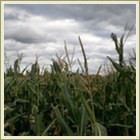 |
Climate Change Makes Corn Thirstier
Headlines warn that increasing temperatures are threatening global crop production. A drought and heat wave swept across the U.S. Midwest last summer, damaging corn and soybean production.
Higher temperatures are certainly part of the problem, but a new study led by Center Fellow David Lobell (Earth Sciences, FSI), associate director of the Center on Food Security and the Environment, finds related impacts in the U.S. are more indirect, and that water stress may be the main culprit.
Read more...
"The Critical Role of Extreme Heat for Maize Production in the United States," Nature Climate Change, March 3, 2013 |
 |
Satellites Provide Insight Into Crop Yields
Satellite data can play a critical role in understanding yield gaps and meeting future crop demand, according to a study by Center Fellow David Lobell (Earth Sciences, FSI), associate director of the Center on Food Security and the Environment. To date, satellite data have played a relatively small role in this field. However, the few examples that exist indicate that remote sensing
can help to overcome some of the inherent spatial and temporal scaling issues associated with field-based approaches, Lobell finds. Improved algorithms to pre-process remote sensing data and
estimate yields, and the increased availability of new, large geospatial datasets on soils, management and weather should also benefit future efforts in this area, according to Lobell.
Read more...
"The Use of Satellite Data for Crop Yield Gap Analysis," Field Crop Research, March 1, 2013 |
 |
Agricultural Climate Adaptation Can Mitigate, Too
Adapting to climate change or mitigating climate change - which would you choose to invest your cash in? A study co-authored by Center Fellow David Lobell (Earth Sciences, FSI), associate director of the Center on Food Security and the Environment, shows that when it comes to agriculture, adaptation measures can also generate significant mitigation effects, making them a highly
worthwhile investment.
Read more...
"Climate Adaptation as Mitigation: The Case of Agricultural Investments," Environmental Research Letters, Feb. 12, 2013 |
| |
Other Food Security Research
"Errors in Climate Datasets and Their Effects on Statistical Crop Models," Agricultural and Forest Meteorology, March 15, 2013, by Center Fellow David Lobell (Earth Sciences, FSI)
"Simulated Hydroclimatic Impacts of Projected Brazilian Sugarcane Expansion," Geophysical Research Letters, March 6, 2013, co-authored by Senior Fellow Chris Field (Biology) and Center Fellow David Lobell (Earth Sciences, FSI)
|
| |
More information about Stanford Woods Institute food security research |
| |
 |
 |
Ensuring Water for Cities
Will global urbanization increase or decrease vulnerability to droughts? An analysis co-authored
by Senior Fellow Steven Gorelick (Earth Sciences) looks at fast-growing Chennai - India's fourth largest
city - as a case study. Like all major cities in India, Chennai does not offer 24/7 water supply. By 2025, urban vulnerability to water shortages (daily per capita supply is under 40 liters during
a drought) is expected to increase due to limited freshwater availability. However, vulnerability is likely to decrease in expanding peri-urban areas as agricultural water is converted to household
use. To reduce vulnerability, the analysis suggests, new forms of urban governance and planning institutions are needed to manage centralized actions by utilities and decentralized actions by millions of people.
Read more...
"The Impact of Urbanization on Water Vulnerability: A Coupled Human-Environment System Approach for Chennai, India," Global Environmental Change, February 2013 |
 |
Advanced Technology Provides Insight Into Saltwater Intrusion
As increasing demand depletes coastal groundwater, saltwater intrusion becomes a growing threat to water sources. Developing effective resource management strategies to limit or prevent this
intrusion requires reliable information about the geologic structure and hydrologic state of an aquifer system. A study co-authored by Senior Fellow Rosemary Knight (Earth Sciences) looks at noninvasive electromagnetic (EM) geophysical
methods as an alternative to installation of costly monitoring wells for characterizing coastal aquifers. The study's results suggest EM methods are capable of reliably identifying a saltwater-saturated zone in an unconfined aquifer.
Read more...
"Application and Evaluation of Electromagnetic Methods for Imaging Saltwater Intrusion in Coastal Aquifers: Seaside Groundwater Basin, California," Geophysics, March 2013 |
 |
A Guide to Water Law
A textbook co-authored by Woods Senior Fellow and Co-Director Buzz Thompson (Law) provides a
detailed look at western and eastern water law in the United States and related policy issues. The book includes discussions of both surface-water and groundwater issues, water institutions,
interstate and international water disputes, and water quality. The new edition also looks at water law as a leading edge in thinking about adaptation to climate change.
Read more...
Legal Control of Water Resources, Cases and Materials (Fifth Edition), West Publishing, 2013 |
| |
Other Freshwater Research
"Use of NMR Logging to Obtain Estimates of Hydraulic Conductivity in the High Plains Aquifer," Water Resources Research, April 15, 2013, co-authored by Senior Fellow Rosemary Knight (Earth Sciences)
"Electrical Resistivity for Characterization and Infiltration Monitoring of a Managed Aquifer
Recharge Pond," Vadose Zone Journal, February 2013, co-authored by Senior Fellow Rosemary
Knight (Earth Sciences) and Woods-affiliated Professor of Civil and Environmental Engineering Peter Kitanidis
|
| |
More information about Stanford Woods Institute freshwater research |
| |
 |
 |
Climate Change-Related Risks and Options for California's Coast
It's up to California's coastal managers to figure out how to respond to climate change-related impacts that could affect thousands of residents, billions of dollars of resources and invaluable
marine ecosystems. An analysis co-authored by Senior Lecturer and Center for Ocean Solutions Executive Director Meg Caldwell (Law) and postdoctoral scholar Ryan Kelly (Center for Ocean Solutions) examines climate change-related coastal risks. Among its recommendations: reform of programs such as federal flood insurance that subsidize high-risk coastal development. The analysis was published as
a chapter in Assessment of Climate Change in the Southwest United States (Island Press, 2013).
Photo credit: Gary Griggs
Read more...
|
 |
How to Ensure Success of Marine Protected Areas
Without the proper enabling conditions, Marine Protected Area (MPA) planning processes can be significantly hindered in their capacity to achieve stated goals. In California, after two
unsuccessful attempts, statewide planning of a network of MPAs was achieved through the California Marine Life Protection Act (MLPA) Initiative. A study co-authored by Senior Lecturer Meg Caldwell (Law) identifies conditions that
contributed to moving the initiative forward, ranging from a strong legal mandate that provided guidance and flexibility to an effective and transparent process design that optimized contributions from stakeholders, scientists and policymakers.
Photo credit: Pete Naylor
Read more...
“Enabling Conditions to Support Marine Protected Area Network Planning: California's Marine Life Protection Act Initiative as a Case Study. Ocean & Coastal Management, March 2013 |
 |
Waves Help Nourish Vital Habitat
Seagrass communities provide vital aquatic habitat, protect shorelines from damage and improve coastal water quality. These increasingly threatened ecosystems depend on the flow of
surrounding water for their survival. In a study led by Stanford postdoctoral scholar Joel Weitzman and co-authored by Senior Fellow and Woods Co-Director Jeff Koseff, researchers analyzed this dependency at a
field site in Florida Bay. They isolated living patches of seagrass in a mobile flow tank and measured how different conditions affected the plants. While nutrient uptake increased with
water speed, this core function was boosted dramatically when the plants were exposed to waves. These results can be used to better guide global seagrass protection efforts and rehabilitation strategies.
Read more...
"Uptake of Dissolved Inorganic Nitrogen by Shallow Seagrass Communities Exposed to Wave-Driven Unsteady Flow," Marine Ecology Progress Series, Feb. 14, 2013 |
| |
Other Oceans Research
"Processes and Patterns of Oceanic Nutrient Limitation," Nature Geoscience,
March 31, 2013, co-authored by Woods-affiliated Professor of Environmental Earth System Science Kevin Arrigo
"Designing a Network of Marine Protected Areas in California: Achievements, Costs, Lessons
Learned and Challenges Ahead," Ocean & Coastal Management, March 2013, co-authored by Senior Lecturer Meg Caldwell (Law)
"California's Marine Life Protection Act Initiative: Supporting
Implementation of Legislation Establishing a Statewide Network of Marine Protected Areas," Ocean & Coastal Management, March 2013, co-authored by Senior Lecturer Meg Caldwell (Law)
"Characteristics of Monochromatic Waves Breaking Over Fringing Reefs," Journal of Coastal
Research, January 2013, co-authored by Senior Fellow Steven Monismith
|
| |
More information about Stanford Woods Institute oceans research |
| |
 |
 |
A Closer Look at Bio-Digesters in Sub-Saharan Africa
Has the substantial investment in domestic bio-digesters - devices that convert human waste into fertilizer through a carbon-neutral process - across sub-Saharan Africa in recent years been
worth it? A study co-authored by Senior Fellow Jenna Davis (Civil and Environmental Engineering) suggests that bio-digester adoption has the potential to reduce fuel-wood use, energy-related expenditures and time-costs of energy
procurement, thereby lowering carbon dioxide emissions and increasing farm incomes. Bio-digester implementation at the countrywide level in Tanzania could potentially access $80 million to
$115 million annually in carbon emissions reduction financing through a U.N.-backed program that provides credits to emission-reduction projects in developing countries, the study asserts.
Read more...
"Economic and Environmental Impacts of Domestic Bio-Digesters: Evidence From Arusha, Tanzania," Energy for Sustainable Development, March 16, 2013 |
 |
Making Developing World Water Systems Sustainable
Development agencies and developing country governments regularly cite "sense of ownership" among community members as a key driver of water system sustainability, but little empirical
evidence exists to support this claim. A study co-authored by Senior Fellow Jenna Davis (Civil and Environmental Engineering) uses data collected from communities across Kenya to test this association. In contrast to prevailing
practice in rural water planning, the authors find that the key determinant of a water system's sustainability is not the strength of households' sense of ownership but of water committee members' sense of ownership.
Read more...
"Does Sense of Ownership Matter for Rural Water System Sustainability? Evidence From Kenya," Journal of Water, Sanitation and Hygiene for Development, March 2013
|
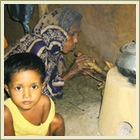 |
Reducing Indoor Air Pollution
Indoor exposure to particulate matter (PM) increases the risk of acute lower respiratory tract infections - the leading cause of death in young children in Bangladesh. A study co-authored by Senior Fellow Stephen Luby (Medicine,
Freeman Spogli Institute for International Studies) revealed higher PM concentrations in households in a low-income community in Bangladesh that primarily burn biomass for cooking and kerosene for
heating and light, among other findings. Young children in this community are exposed to indoor PM concentrations seven times greater than those recommended by World Health Organization guidelines.
The study suggests that interventions to reduce biomass burning could result in a 40 percent daily reduction of PM concentrations.
Photo credit: Lynn Hildemann
Read more...
"Seasonal Concentrations and Determinants of Indoor Particulate Matter in a Low-Income Community in Dhaka, Bangladesh," Environmental Research, February 2013 |
| |
Other Public Health Research
"Nipah Virus Outbreak in Bangladesh With Nosocomial and Corpse to Human Transmission," Emerging Infectious Diseases, February 2013, co-authored by Senior Fellow Stephen Luby (Medicine, FSI)
"Ebola Virus Antibodies in Fruit Bats, Bangladesh," Emerging Infectious Diseases, February 2013, co-authored by Senior Fellow Stephen Luby (Medicine, FSI)
"Hands and Water as Vectors of Diarrheal Pathogens in Bagamoyo, Tanzania," Environmental Science & Technology, Jan. 2, 2013, co-authored by Senior Fellow Jenna Davis (Civil and Environmental Engineering), Woods-affiliated Associate Professor of Civil and Environmental Engineering Alexandria Boehm and Woods-affiliated postdoctoral scholar Amy Pickering (Water, Health and Development)
|
| |
More information about Stanford Woods Institute public health research |
| |
 |
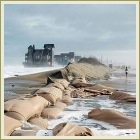 |
Americans Back Preparation for Extreme Weather and Sea Level Rise
A survey commissioned by the Stanford Woods Institute and the Center for Ocean Solutions finds that an overwhelming majority
of Americans want to prepare in order to minimize the damage likely to be caused by global warming-induced sea level rise and storms. A majority also want people whose properties and businesses are
located in hazard-prone areas - not the government - to foot the bill for this preparation, according to the survey's director, Senior Fellow Jon Krosnick (Communication and Political Science). Specifically, 82 percent of the Americans surveyed said that people and organizations should prepare for the damage likely to be caused by sea
level rise and storms, rather than simply deal with the damage after it happens.
Read more...
"Stanford University Climate Adaptation National Poll," Conducted by GfK Custom Research North America from March 3 to March 18, 2013 |
| |
More information about Stanford Woods Institute public opinion research |
| |
 |
 |
An Alternative Energy Future for New York
New York Gov. Andrew Cuomo will soon decide whether to approve hydraulic fracturing ("fracking") for natural gas in the state. To date, no alternative to expanded gas drilling has been
proposed. But a new study co-authored by Senior Fellow Mark Jacobson (Civil and Environmental Engineering) finds that it is technically and economically feasible to convert New York's all-purpose energy
infrastructure to one powered by wind, water and sunlight. The plan shows the way to a sustainable, inexpensive and reliable energy supply that creates local jobs and saves the state billions of dollars in pollution-related costs.
Read more...
"Examining the Feasibility of Converting New York State's All-Purpose Energy Infrastructure to One Using Wind, Water and Sunlight," Energy Policy, March 13, 2013 |
 |
Solar Photovoltaic Industry a Net Energy Producer
The construction of the photovoltaic power industry since 2000 has required an enormous amount of energy, mostly from fossil fuels. The good news is that the clean electricity from all the
installed solar panels has likely just surpassed the energy going into the industry's continued growth, according to a study co-authored by Senior Fellow and Global Climate and Energy Project Director Sally Benson (Energy Resources Engineering).
Read more...
"Energy Balance of the Global Photovoltaic (PV) Industry - Is the PV Industry a Net Electricity Producer?" Environmental Science and Technology, Feb. 26, 2013 |
 |
New Way to Measure Carbon Footprint of Grid-Scale Batteries
Because the U.S. electrical grid has virtually no storage capacity, grid operators can't stockpile surplus wind and solar energy for delivery at night or when the wind isn't blowing. The fossil
fuel required to build new batteries and other large-scale storage devices for solar and wind power could negate some of the environmental benefits of installing new solar and wind farms, according to an analysis co-authored by Senior Fellow Sally
Benson (Energy Resources Engineering). Benson, the director of Stanford's Global Climate and Energy Project, and Stanford postdoctoral scholar Charles Barnhart (Energy Resources Engineering) developed a novel way to calculate the energetic cost of building large batteries
and other storage technologies.
Read more...
"On the Importance of Reducing the Energetic and Material Demands of Electrical Energy Storage," Energy & Environmental Science, Jan. 30, 2013 |
| |
More information about Stanford Woods Institute
sustainable development research |
| |
|
|
| |
Find Us on the Web
   |
|
The Stanford Woods Institute Research Digest is a quarterly report of findings by Woods fellows and affiliated faculty, as well as fellows with the Institute's Leopold Leadership Program. Current and past issues are online.
Contact us to subscribe or provide information about new and forthcoming research.
To learn more about the Stanford Woods Institute for the Environment, visit our website or email us.
Stanford Woods Institute for the Environment
Jerry Yang & Akiko Yamazaki Environment & Energy Building - MC 4205
473 Via Ortega
Stanford, CA 94305 |
|
|
|
